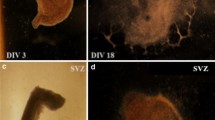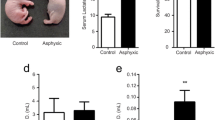Summary.
The effect of perinatal asphyxia on brain development was studied with organotypic cultures from substantia nigra, neostriatum and neocortex. Asphyxia was induced by immersing foetuses-containing uterine horns removed from ready-to-deliver rats into a water bath for 20 min. Following asphyxia, the pups were nursed by a surrogate dam and sacrificed after three days for preparing organotypic cultures. Non-asphyxiated caesarean-delivered pups were used as controls. Morphological features and cell viability were recorded during in vitro development. At day in vitro (DIV) 24, the cultures were treated for immunocytochemistry using antibodies against the N-methyl-D-aspartate receptor subunit 1 (NR1) and tyrosine hydroxylase (TH).
While in vitro survival was similar in cultures from both asphyxiated and control animals, differences were observed when the neuronal phenotype was assessed. Compared to controls, the total number of NR1-positive neurons in substantia nigra, as well as the number of secondary to higher level branching of TH-positive neurites from asphyxiated pups were decreased, illustrating the vulnerability of the dopaminergic systems to perinatal asphyxia.
Similar content being viewed by others
Author information
Authors and Affiliations
Rights and permissions
About this article
Cite this article
Klawitter, V., Morales, P., Johansson, S. et al. Effects of perinatal asphyxia on cell survival, neuronal phenotype and neurite growth evaluated with organotypic triple cultures. Amino Acids 28, 149–155 (2005). https://doi.org/10.1007/s00726-005-0161-5
Received:
Accepted:
Published:
Issue Date:
DOI: https://doi.org/10.1007/s00726-005-0161-5




